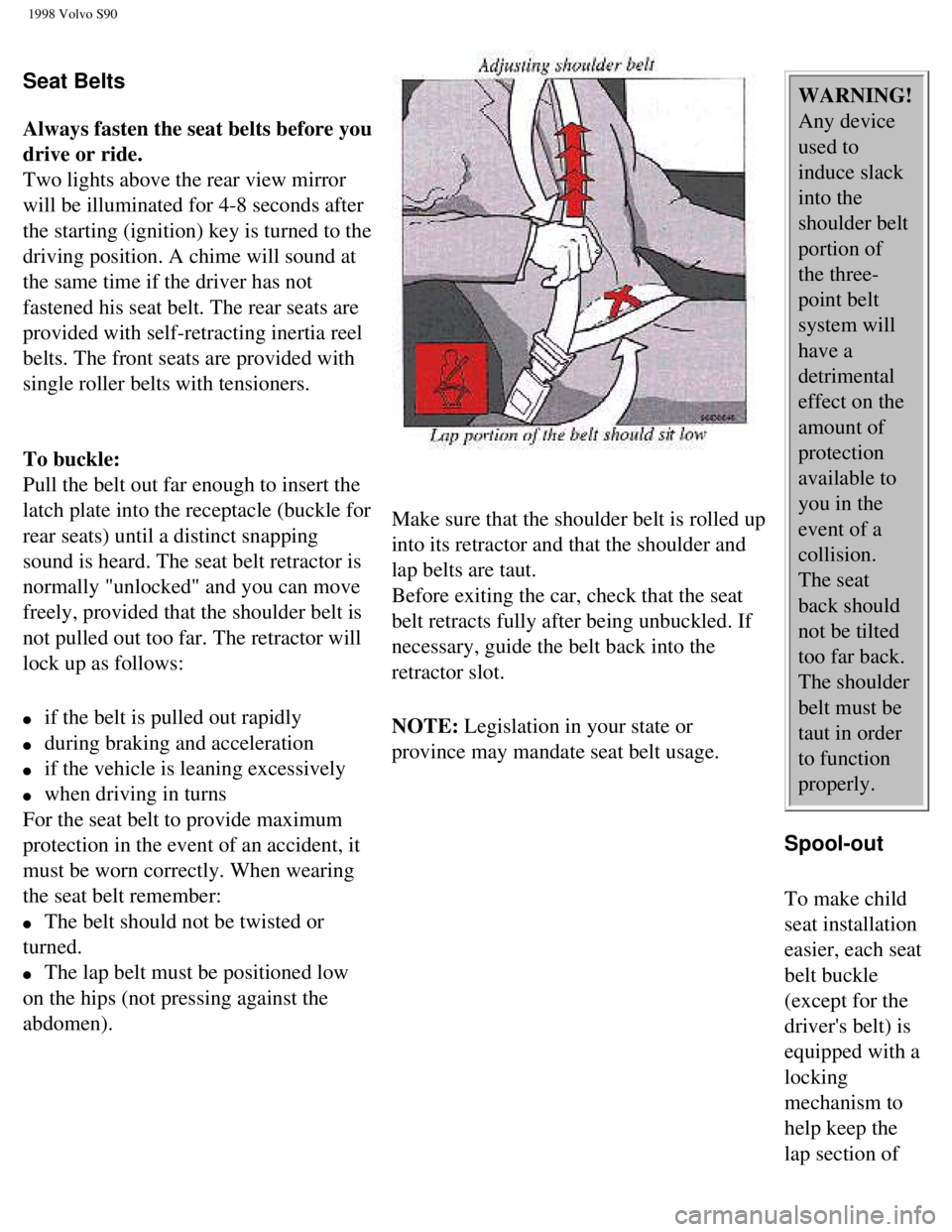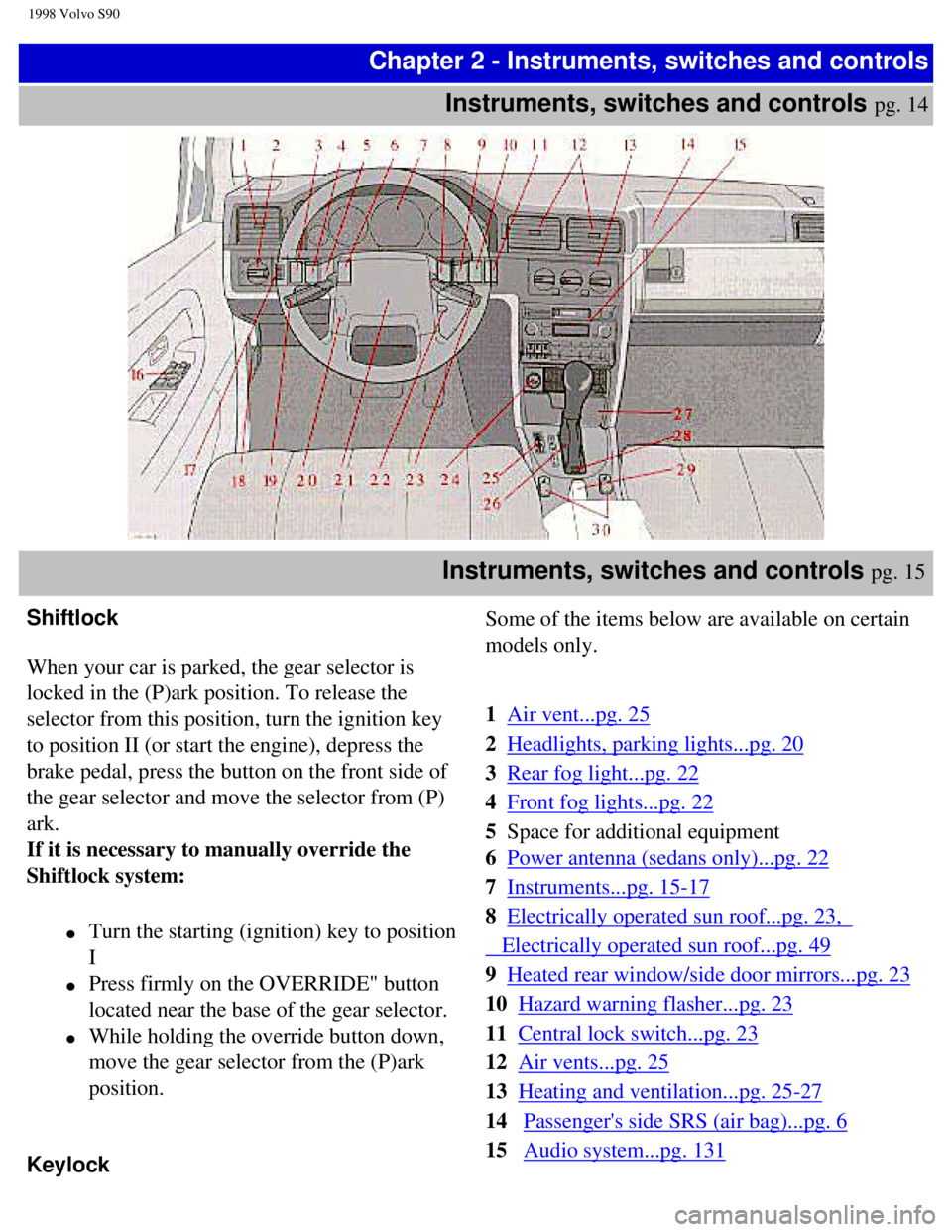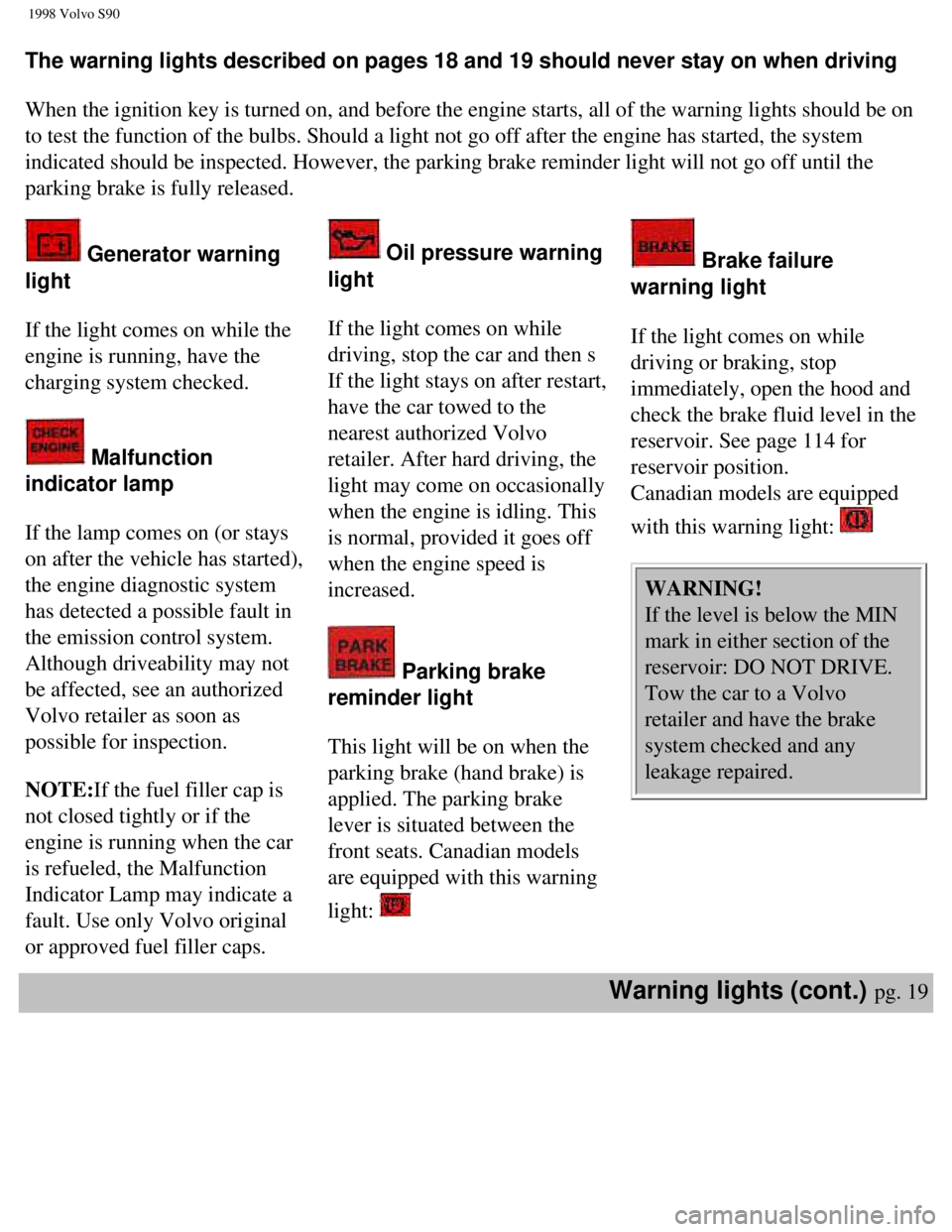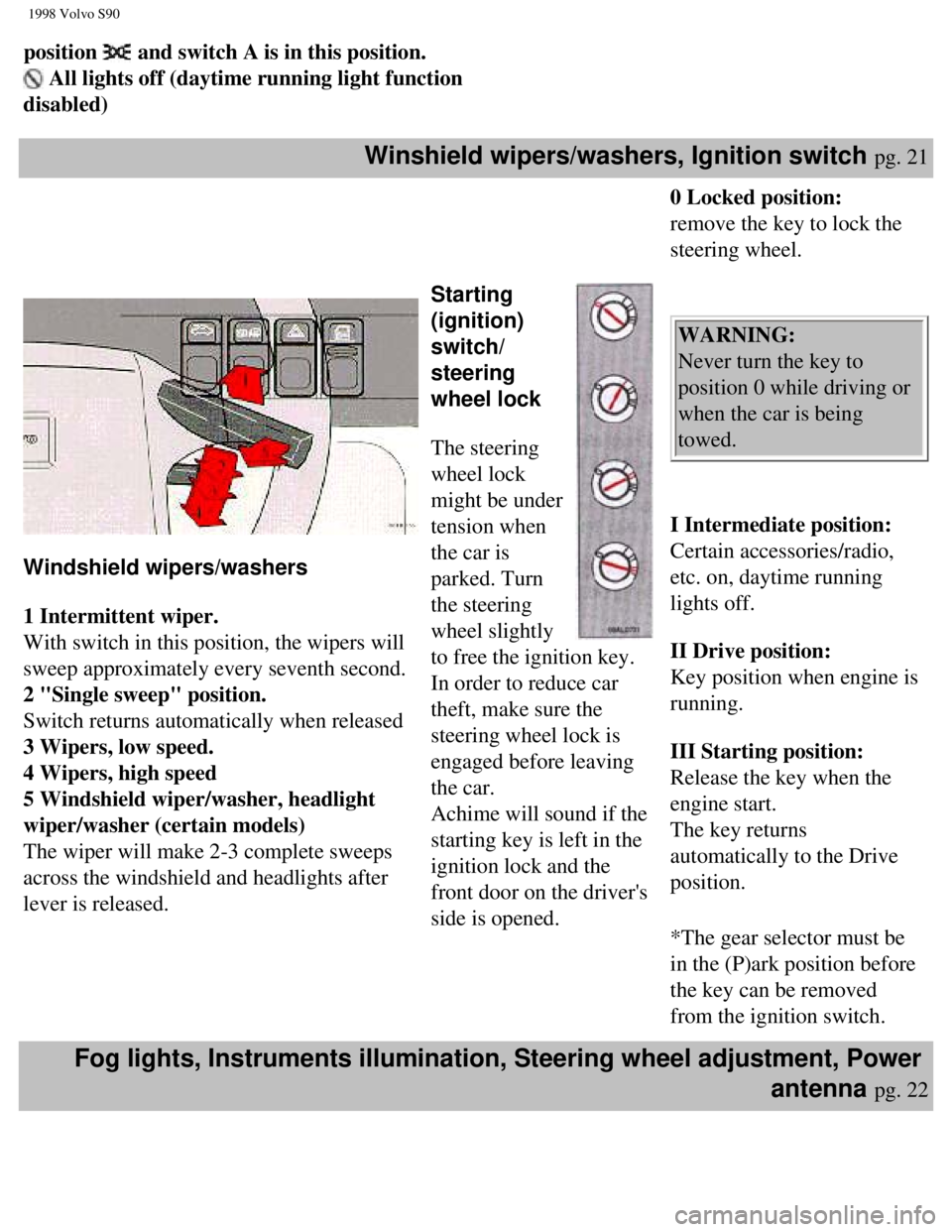1998 VOLVO V90 key
[x] Cancel search: keyPage 6 of 175

1998 Volvo S90
Seat Belts
Always fasten the seat belts before you
drive or ride.
Two lights above the rear view mirror
will be illuminated for 4-8 seconds after
the starting (ignition) key is turned to the
driving position. A chime will sound at
the same time if the driver has not
fastened his seat belt. The rear seats are
provided with self-retracting inertia reel
belts. The front seats are provided with
single roller belts with tensioners.
To buckle:
Pull the belt out far enough to insert the
latch plate into the receptacle (buckle for
rear seats) until a distinct snapping
sound is heard. The seat belt retractor is
normally "unlocked" and you can move
freely, provided that the shoulder belt is
not pulled out too far. The retractor will
lock up as follows:
l if the belt is pulled out rapidly
l during braking and acceleration
l if the vehicle is leaning excessively
l when driving in turns
For the seat belt to provide maximum
protection in the event of an accident, it
must be worn correctly. When wearing
the seat belt remember:
l The belt should not be twisted or
turned.
l The lap belt must be positioned low
on the hips (not pressing against the
abdomen).
Make sure that the shoulder belt is rolled up
into its retractor and that the shoulder and
lap belts are taut.
Before exiting the car, check that the seat
belt retracts fully after being unbuckled. If
necessary, guide the belt back into the
retractor slot.
NOTE: Legislation in your state or
province may mandate seat belt usage.
WARNING!
Any device
used to
induce slack
into the
shoulder belt
portion of
the three-
point belt
system will
have a
detrimental
effect on the
amount of
protection
available to
you in the
event of a
collision.
The seat
back should
not be tilted
too far back.
The shoulder
belt must be
taut in order
to function
properly.
Spool-out
To make child
seat installation
easier, each seat
belt buckle
(except for the
driver's belt) is
equipped with a
locking
mechanism to
help keep the
lap section of
file:///K|/ownersdocs/1998/1998_SV90/98S90_001.htm (2 of 5)12/30/2006 \
1:52:33 PM
Page 13 of 175

1998 Volvo S90
characteristic and does not
indicate fire. area above the glove
compartment) or the area
affected by air bag
deployment (see
illustration).
l There should be no loose
articles, e.g. coffee cups,
on the floor, seat or dash
area.
l Never try to open the
SRS cover on the steering
wheel or the passenger
side SRS hatch. This
should only be done by
an authorized Volvo
service technician.
l Failure to follow these
instructions can result in
injury to the vehicle
occupants in an accident.
VOLVO SRS (cont.) pg. 7
NOTE:The information on this page does not pertain
to the Side Impact Protection System airbags.
When are the airbags deployed?
The SRS system is designed to deploy during certain
frontal or front-angular collisions, impacts, or
decelerations, depending in the crash severity, angle,
speed, and object impacted. The SRS sensor is
designed to react to both the impact of the collision
and the inertial forces generated by it and to
determine if the intensity of the collision is sufficient
for the airbags to be deployed.
WARNING! The SRS is designed to help prevent
serious injury. Deployment occurs very quickly
and with considerable force. During normal
deployment and depending on variables such as
seating position, one may experience abrasions,
bruises, swellings, or other injuries as a result of
airbag(s) deployment.
Seat belts - the heart of the Volvo safety
system
The heart of the Volvo safety system is the three-
point seat belt (a Volvo invention)! In order for the
SRS system to provide the protection intended, seat
belts must be worn at all times by everyone in the car.
The SRS system is a supplement to the seat belts.
WARNING! If your car has been subjected to
flood conditions (e.g. soaked carpeting/standing
water on the floor of the vehicle) or if your car has
become flood-damaged in any way, do not
attempt to start the vehicle or put the key in the
ignition before disconnecting the battery (see
below). This may cause airbag deployment which
could result in personal injury. Have the car towed
to an authorized Volvo retailer for repairs.
Automatic transmission only:
Before attempting to tow the car, use the
following procedure to override the shiftlock
file:///K|/ownersdocs/1998/1998_SV90/98S90_004.htm (4 of 7)12/30/2006 \
1:52:34 PM
Page 14 of 175

1998 Volvo S90
If the airbags have been deployed, we recommend
the following:
l Have the car towed to an authorized Volvo
retailer. Never drive with the airbags
deployed.
l Have an authorized Volvo retailer replace the
SRS system components.
l Use only new, Genuine Volvo Parts when
replacing SRS components (airbags, seat
belts, tensioners, etc.).
When are the airbags NOT deployed?
Not all frontal collisions activate the SRS system. If
the collision involves a non-rigid object (e.g., a snow
drift or bush), or a rigid, fixed object at a low speed,
the SRS system will not necessarily deploy. Airbags
do not normally deploy in a side impact collision, in
a collision from the rear or in a rollover situation.
The amount of damage to the bodywork does not
reliably indicate if the airbags should have deployed
or not.
system to move the gear selector to the neutral
position.
l Disconnect the battery
l Wait at least one minute
l Insert the key in the ignition and turn it to
position 1
l Press firmly on the shiftlock override
button (located near the base of the gear
selector).
l While holding the override button down,
move the gear selector from the park
position.
WARNING! Never drive with the airbags
deployed. The fact that they hang out can impair
the steering of your car. Other safety systems can
also be damaged. The smoke and dust formed
when the airbags are deployed can cause skin and
eye irritation in the event of prolonged exposure.
Volvo Side Impact Protection System (SIPS) airbag pg. 8
WARNING!
l The SIPS airbag
system is a
supplement to the
Side Impact
Protection System
and the three-point
seat belt system. It
is not designed to
deploy during
collisions from the
front or rear of the
car or in rollover
situations.
l Only Volvo
approved seat
1- Airbag, 2 - cable, 3 - sensor
unit, 4 - gas generator
file:///K|/ownersdocs/1998/1998_SV90/98S90_004.htm (5 of 7)12/30/2006 \
1:52:34 PM
Page 15 of 175

1998 Volvo S90
SIPS airbag decal*
SIPS airbag (front seats only)
As an enhancement to the structural Side
Impact Protection System built into your
car, your car is also equipped with Side
Impact Protection System (SIPS) airbags.
The SIPS airbag system consists of airbag
modules built into the sides of both front
seat backrests (1), cables (2) from these
modules to the mechanical sensor units (3)
and gas generators (4).
The SIPS airbag system is designed to help
increase occupant protection in the event of
certain side impact collisions. The SIPS
airbags are designed to deploy only during
certain side-impact collisions, depending on
the crash severity, angle, speed, and point of
impact. The airbags are not designed to
deploy in all side impact situations.
covers may be
used. The use of
non-approved
aftermarket seat
covers may impede
SIPS airbag
deployment.
l No objects,
accessory
equipment or
stickers may be
placed on, attached
to or installed near
the SIPS airbag
system or in the
area affected by
SIPS airbag
deployment (see
illustration to the
right above).
l Never try to open
or repair any
components of the
SIPS airbag system.
This should only be
done by an
authorized Volvo
service technician.
l For best protection
from the SIPS
airbag system, both
front seat occupants
should sit in an
upright position
with the seat belt
properly fastened.
NOTE: SIPS airbag
deployment (one airbag)
occurs only on the side of
the vehicle affected by the
impact.
WARNING!
l Never drive with the
airbags deployed. The
fact that they hang out
can impair the steering
of your car. Other
safety systems can
also be damaged. The
smoke and dust
formed when the
airbags are deployed
can cause skin and eye
irritation in the event
of prolonged
exposure.
l If your car has been
subjected to flood
conditions (e.g.
soaked carpeting/
standing water on the
floor of the vehicle) or
if your car has become
flood-damaged in any
way, do not attempt to
start the vehicle or put
the key in the ignition
before disconnecting
the battery. This may
cause airbag
deployment which
could result in
personal injury. Have
the car towed to an
authorized Volvo
retailer for repairs.
file:///K|/ownersdocs/1998/1998_SV90/98S90_004.htm (6 of 7)12/30/2006 \
1:52:34 PM
Page 22 of 175

1998 Volvo S90
Chapter 2 - Instruments, switches and controlsInstruments, switches and controls
pg. 14
Instruments, switches and controls pg. 15
Shiftlock
When your car is parked, the gear selector is
locked in the (P)ark position. To release the
selector from this position, turn the ignition key
to position II (or start the engine), depress the
brake pedal, press the button on the front side of
the gear selector and move the selector from (P)
ark.
If it is necessary to manually override the
Shiftlock system:
l Turn the starting (ignition) key to position
I
l Press firmly on the OVERRIDE" button
located near the base of the gear selector.
l While holding the override button down,
move the gear selector from the (P)ark
position.
Keylock
Some of the items below are available on certain
models only.
1
Air vent...pg. 25
2
Headlights, parking lights...pg. 20
3
Rear fog light...pg. 22
4
Front fog lights...pg. 22
5 Space for additional equipment
6
Power antenna (sedans only)...pg. 22
7
Instruments...pg. 15-17
8
Electrically operated sun roof...pg. 23,
Electrically operated sun roof...pg. 49
9
Heated rear window/side door mirrors...pg. 23
10
Hazard warning flasher...pg. 23
11
Central lock switch...pg. 23
12
Air vents...pg. 25
13
Heating and ventilation...pg. 25-27
14
Passenger's side SRS (air bag)...pg. 6
15
Audio system...pg. 131
file:///K|/ownersdocs/1998/1998_SV90/98S90_014.htm (1 of 3)12/30/2006 \
1:52:36 PM
Page 23 of 175

1998 Volvo S90
This means that when you switch off the ignition,
the gear selector must be in the (P)ark position
before the starting (ignition) key can be removed
from the ignition switch.
Anti-Lock Brake System (ABS)
The ABS system in your car performs a self-
diagnostic test when the vehicle is started and at
4 mph (6km/h). The driver may detect one
pulsation of the brake pedal and a sound will be
audible from the ABS control module. This is
normal.
The pages in this section provide detailed
descriptions of the vehicle's instruments and
controls.
Note that vehicles may be equipped differently,
depending on special legal requirements. 16 Controls for electrically operated windows...
pg. 29
and side-view mirrors...pg. 35
17
Instrument illumination...pg. 22
18
Hood-release handle...pg. 39
19
Turn signals, high/low beams...pg. 20
cruise control...pg. 24
20
Adjustable steering wheel...pg. 22
21
SRS (air bag)/Horn...pg. 4
22
Starting (ignition) switch/steering wheel
lock...pg. 21
23
Windshield wiper/washer...pg. 21
Tailgate wiper/washer (wagons)...pg. 23
24
Cigarette lighter...pg. 30
25
Transmission mode selector buttons...pg. 59
26
Gear selector...pg. 58
27
Ash tray...pg. 30
28
Shiftlock release (override) button...pg. 61
29
Parking brake...pg. 30
30
Electrically-heated front seats (certain
models)...pg. 28
Instruments pg. 16
file:///K|/ownersdocs/1998/1998_SV90/98S90_014.htm (2 of 3)12/30/2006 \
1:52:36 PM
Page 26 of 175

1998 Volvo S90
The warning lights described on pages 18 and 19 should never stay on whe\
n driving
When the ignition key is turned on, and before the engine starts, all of\
the warning lights should be on
to test the function of the bulbs. Should a light not go off after the e\
ngine has started, the system
indicated should be inspected. However, the parking brake reminder light\
will not go off until the
parking brake is fully released.
Generator warning
light
If the light comes on while the
engine is running, have the
charging system checked.
Malfunction
indicator lamp
If the lamp comes on (or stays
on after the vehicle has started),
the engine diagnostic system
has detected a possible fault in
the emission control system.
Although driveability may not
be affected, see an authorized
Volvo retailer as soon as
possible for inspection.
NOTE:If the fuel filler cap is
not closed tightly or if the
engine is running when the car
is refueled, the Malfunction
Indicator Lamp may indicate a
fault. Use only Volvo original
or approved fuel filler caps.
Oil pressure warning
light
If the light comes on while
driving, stop the car and then s
If the light stays on after restart,
have the car towed to the
nearest authorized Volvo
retailer. After hard driving, the
light may come on occasionally
when the engine is idling. This
is normal, provided it goes off
when the engine speed is
increased.
Parking brake
reminder light
This light will be on when the
parking brake (hand brake) is
applied. The parking brake
lever is situated between the
front seats. Canadian models
are equipped with this warning
light:
Brake failure
warning light
If the light comes on while
driving or braking, stop
immediately, open the hood and
check the brake fluid level in the
reservoir. See page 114 for
reservoir position.
Canadian models are equipped
with this warning light:
WARNING!
If the level is below the MIN
mark in either section of the
reservoir: DO NOT DRIVE.
Tow the car to a Volvo
retailer and have the brake
system checked and any
leakage repaired.
Warning lights (cont.) pg. 19
file:///K|/ownersdocs/1998/1998_SV90/98S90_017.htm (2 of 7)12/30/2006 \
1:52:36 PM
Page 29 of 175

1998 Volvo S90
position and switch A is in this position.
All lights off (daytime running light function
disabled)
Winshield wipers/washers, Ignition switch pg. 21
Windshield wipers/washers
1 Intermittent wiper.
With switch in this position, the wipers will
sweep approximately every seventh second.
2 "Single sweep" position.
Switch returns automatically when released
3 Wipers, low speed.
4 Wipers, high speed
5 Windshield wiper/washer, headlight
wiper/washer (certain models)
The wiper will make 2-3 complete sweeps
across the windshield and headlights after
lever is released.
Starting
(ignition)
switch/
steering
wheel lock
The steering
wheel lock
might be under
tension when
the car is
parked. Turn
the steering
wheel slightly
to free the ignition key.
In order to reduce car
theft, make sure the
steering wheel lock is
engaged before leaving
the car.
Achime will sound if the
starting key is left in the
ignition lock and the
front door on the driver's
side is opened. 0 Locked position:
remove the key to lock the
steering wheel.
WARNING:
Never turn the key to
position 0 while driving or
when the car is being
towed.
I Intermediate position:
Certain accessories/radio,
etc. on, daytime running
lights off.
II Drive position:
Key position when engine is
running.
III Starting position:
Release the key when the
engine start.
The key returns
automatically to the Drive
position.
*The gear selector must be
in the (P)ark position before
the key can be removed
from the ignition switch.
Fog lights, Instruments illumination, Steering wheel adjustment, Power antenna
pg. 22
file:///K|/ownersdocs/1998/1998_SV90/98S90_017.htm (5 of 7)12/30/2006 \
1:52:36 PM